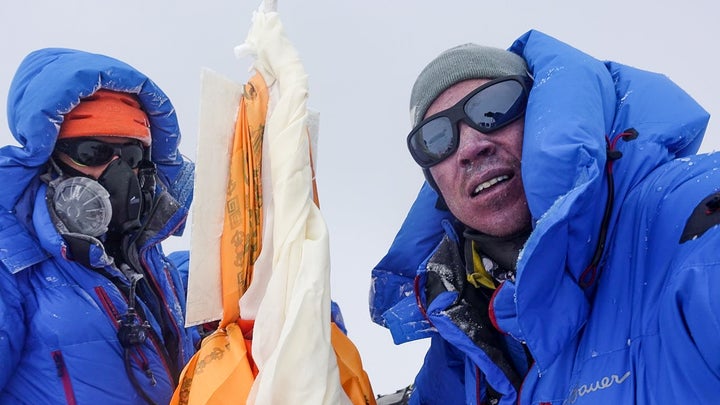Is A Week-Long Everest Climb With Anesthetic Gas Possible, And Is It Safe?

Table of Contents
The Physiological Challenges of a Rapid Everest Ascent
A successful Everest expedition typically takes weeks, even months, of careful acclimatization and strategic climbing. Attempting a week-long ascent fundamentally ignores the crucial role of gradual adaptation to extreme altitude.
Altitude Sickness and its Severity
The thin air at high altitude presents a formidable challenge. Rapid ascent dramatically increases the risk of severe altitude sickness, including:
- Acute Mountain Sickness (AMS): Symptoms range from headaches and nausea to dizziness and fatigue.
- High-Altitude Pulmonary Edema (HAPE): Fluid builds up in the lungs, leading to shortness of breath and potentially death.
- High-Altitude Cerebral Edema (HACE): Fluid accumulates in the brain, causing neurological symptoms like confusion, seizures, and coma. HACE has a high mortality rate.
The mortality rate associated with these conditions is significant, especially without proper acclimatization. Acclimatization allows the body to gradually adjust to decreasing oxygen levels, reducing the risk of these life-threatening conditions. A week-long climb drastically reduces the time for this crucial adaptation process.
Physical Strain and Exhaustion
Even without altitude sickness, the physical demands of climbing Everest are extreme. Climbers carry heavy loads, navigate treacherous terrain, and endure freezing temperatures and unpredictable weather. A rapid ascent exacerbates this physical strain, leading to:
- Exhaustion and Muscle Failure: The body struggles to recover and repair muscle tissue damaged during strenuous activity.
- Increased Risk of Injuries: Fatigue compromises judgment and coordination, increasing the likelihood of falls and other injuries.
- Compromised Immune System: Physical stress weakens the immune system, making climbers more susceptible to infections.
The combination of altitude sickness and extreme physical exertion dramatically increases the risk of serious injury or death during a rapid ascent.
The Role of Anesthetic Gases in High-Altitude Climbing
The idea of using anesthetic gases to mitigate fatigue and pain during a rapid Everest climb is inherently flawed and dangerous.
Potential Benefits and Drawbacks
Theoretically, anesthetic gases could reduce pain and fatigue, allowing climbers to push their bodies harder. However, the risks far outweigh any potential benefits:
- Respiratory Depression: Anesthetic gases can suppress breathing, especially at high altitude where oxygen is already scarce.
- Impaired Judgment: Reduced awareness and cognitive function dramatically increases the risk of accidents.
- Increased Susceptibility to Altitude Sickness: The body's ability to cope with altitude is further compromised by the effects of anesthetic gases.
The ethical considerations are equally troubling. Using anesthetic gases to accelerate a climb prioritizes speed over safety, potentially endangering both the climber and any support team. Furthermore, there is no established research supporting the safe and effective use of anesthetic gases at such extreme altitudes.
Practical Challenges of Using Anesthetic Gas on Everest
Logistically, using anesthetic gases on Everest presents significant challenges:
- Transportation and Storage: Carrying and storing enough gas at extreme altitude is extremely difficult.
- Administration: Administering the gas safely and effectively at high altitude requires specialized medical expertise, which is not readily available.
- Environmental Impact: The disposal of used gas canisters adds to the already significant environmental burden on Everest.
The added weight and complexity would only further strain climbers already pushed to their physical limits.
Safety and Feasibility Assessment
A week-long Everest climb with anesthetic gas is, in the opinion of nearly all mountaineering experts and medical professionals, not only highly improbable but incredibly dangerous.
Expert Opinions on the Viability of a Week-Long Climb
The mountaineering community universally condemns any attempt at such a reckless endeavor. Experienced climbers and medical experts emphasize the importance of acclimatization and a gradual ascent. The risks involved in a week-long climb, amplified by the use of anesthetic gas, are simply unacceptable.
Risk Mitigation Strategies (If Applicable)
No conceivable mitigation strategy could adequately address the inherent dangers of a week-long Everest climb with anesthetic gas. The risks are far too significant, and any attempt to mitigate them would only serve to further complicate an already perilous undertaking.
Ethical Considerations and Legal Ramifications
Attempting a week-long Everest climb with anesthetic gas raises serious ethical and legal concerns.
Ethical Concerns Regarding Expedited Climbs
Prioritizing speed over safety is ethically questionable. Such an approach disregards the risks to the climber, any support team, and the environment. Responsible mountaineering practices prioritize safety and respect for the mountain and its environment.
Legal Regulations Regarding Anesthetic Gas Usage
While specific regulations concerning anesthetic gas use in mountaineering may vary, the inherent risks associated with such an endeavor would likely violate various safety regulations and potentially result in legal repercussions.
Conclusion
The notion of a week-long Everest climb with anesthetic gas is not only infeasible but also incredibly dangerous. The physiological challenges of rapid ascent, combined with the inherent risks of using anesthetic gases at extreme altitude, create an unacceptably high risk of serious injury or death. Prioritizing safety is paramount in mountaineering. Responsible and ethical practices, including thorough acclimatization and a gradual ascent, are essential for a safe and successful Everest expedition. We strongly discourage any attempts at a week-long Everest climb with anesthetic gas or any other methods that compromise safety. Choose safe Everest climbs; choose responsible Everest expeditions.

Featured Posts
-
 Celtics Sold For 6 1 Billion A New Era For Boston Basketball
May 16, 2025
Celtics Sold For 6 1 Billion A New Era For Boston Basketball
May 16, 2025 -
 Analyzing Jd Vances Response To Bidens Ukraine Policy Critique
May 16, 2025
Analyzing Jd Vances Response To Bidens Ukraine Policy Critique
May 16, 2025 -
 Riscuri Apa De Robinet Ghid Pentru Consumatori Din Romania
May 16, 2025
Riscuri Apa De Robinet Ghid Pentru Consumatori Din Romania
May 16, 2025 -
 Complete Sweep Rays Dominate Padres In Series
May 16, 2025
Complete Sweep Rays Dominate Padres In Series
May 16, 2025 -
 Foot Lockers New Global Headquarters A Florida Relocation
May 16, 2025
Foot Lockers New Global Headquarters A Florida Relocation
May 16, 2025
